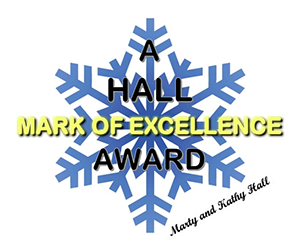 This coverage is made possible through the generous support of Marty and Kathy Hall and A Hall Mark of Excellence Award. To learn more about A Hall Mark of Excellence Award, or to learn how you can support FasterSkier’s coverage, please contact info@fasterskier.com.
This coverage is made possible through the generous support of Marty and Kathy Hall and A Hall Mark of Excellence Award. To learn more about A Hall Mark of Excellence Award, or to learn how you can support FasterSkier’s coverage, please contact info@fasterskier.com.
On Saturday in Trondheim, Norway, the first Skiathlon of the year was held. Competitors skied a 10 kilometer Classic leg followed by a 10 kilometer Freestyle leg. In the men’s race, the prevailing question was which Norwegian would win? The last time a non-Norwegian male won a distance World Cup competition was 24 races ago going back to February 2022. The Norwegian winning streak has gained a kind of life of its own with spectators and pundits wondering when, and if, it will end. The other big question was how would Joannes Hosflot Klaebo (NOR) perform? When there’s a Sprint race, everyone expects Klaebo to win—a distance race— not so much. This year his best distance finish was seventh place. His Skiathlon performances have been erratic. The last time he raced a Skiathlon in the World cup, he failed to finish. However, he did have a second place finish in the World Championships last year. So, the range of predictions were quite diverse.
The weather was a factor with mist and temperatures in the mid-40s leading to klister becoming the only option for the Classic leg. The weather notwithstanding, form was maintained today as Klaebo took the top spot on the podium. A non-Norwegian was able to fight to the podium with Andrew Musgrave (GBR) taking second. Didrik Toenseth (NOR) was third.
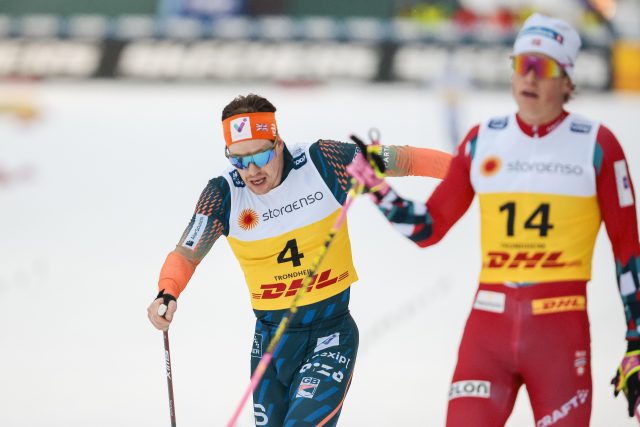
The Americans threw everything they could at the race, fielding seven skiers: the second largest representation by country in the race— behind only Norway. The top American finisher was Ben Ogden in 17th, 1:30 off the lead. Gus Schumacher was 32nd, Scott Patterson, 41st, Zanden McMullen, 45th, JC Schoonmaker, 50th, Luke Jager, 52nd, and John Steel Hagenbuch 56th.
The top Canadian finisher was Antoine Cyr in 21st. He was followed by Olivier Leveille in 43rd.
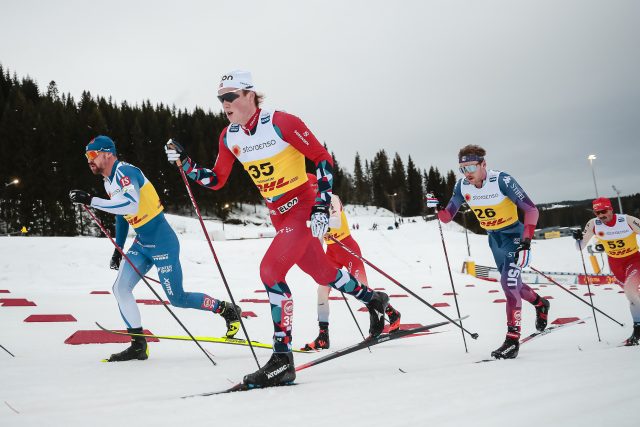
Men’s 20 k Skiathlon
The men began at a somewhat aggressive pace with Andrew Musgrave (GBR) and Johannes Hoesflot Klaebo (NOR) setting the early pace. Very early on it was clear that some racers were going to have a long day, having missed the kick wax. U.S. coach Chris Grover was able to add some insight into the kick wax scenario. “We had gotten some rain and things were beginning to transform,” he said. “It was tricky because there was a colder snowpack underneath. The guys ran into some klisters that were icing and some that were going pretty good, so hats off to the service team. It was an absolutely huge day for the service team in terms of ski preparation.”
At a relatively early point, 2.1 kilometers into the race, the pack began to get strung out a little, Calle Halfvarsson (SWE) moved to the front with Klaebo. Halfvarsson would make himself a presence toward the front for much of the race.
The course had several spots where World Cup overall bonus points were awarded. Klaebo pushed to the front to take the lead at the first bonus point marker at 3.9 kilometers, which put the rest of the field under additional stress. Awarding bonus points seemed to have had its desired effect of keeping the field motivated to race hard the entire way.
After the bonus point sprint, things settled back down a little and Musgrave went back to the lead. Musgrave has definitely become a fan favorite over the years having taken on the role of the plucky underdog. But today, he was determined to prove that he was more than that. At 4.7 kilometers he had pushed to the front and looked very strong. At this point the top American was Ben Ogden in 17th.
Ogden continued to hang with the main pack, and at 7.2 kilometers he was only nine seconds off the leaders. But at the front it was Klaebo and Musgrave continuing to force the pace jockeying back and forth for the lead. The hard pace continued to string out the field even further. At this point, other than Musgrave, the only non-Norwegians at the front were Halfvrasson and Jens Burman (SWE). Ogden was still going strong, hanging with the lead pack.
When the skiers were a kilometer from the ski exchange the leaders turned up the pace even more. Klaebo clearly wanted to lead entering the stadium ski exchange. As they entered the stadium, there was a group of about 14 skiers in the lead, with Klaebo going to the front of the pack. Klaebo was first out of the ski exchange along with about half a dozen countrymen. Ogden was in 18th, 21.5 seconds off the lead.
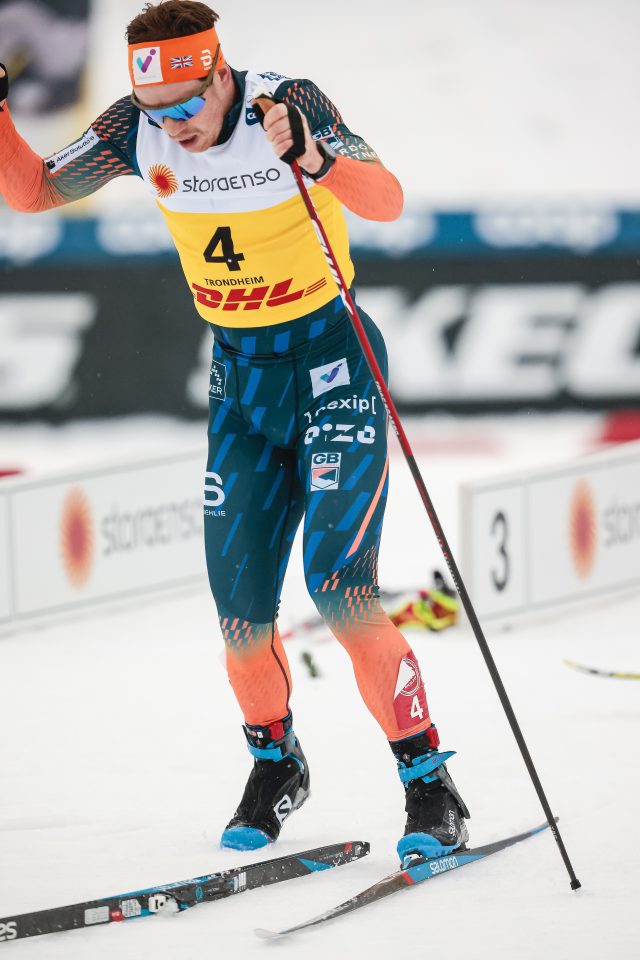
Musgrave had a troublesome ski exchange, and it almost cost him dearly. He fumbled the switch from Classic to Skate skis struggling to get his foot into the binding. This cost him precious seconds. The lead group left the ski exchange without him.
Grover provided some insight to FasterSkier about how the new fluoro rules could cause ski exchange problems. He said that, “the Skate skis can be placed in the transition up to ten minutes before the start of the Skate leg. In the past, athletes placed their own Skate skis in their pits for the exchange, and now coaches or technicians do that after they’ve already started.” He pointed out that this could lead to unintended consequences, “it’s the first time [Musgrave] hasn’t placed his own skis in the exchange. Athletes have different styles in how they set up their skis, whether they straddle one of them and they move right to right, or they come in and they straddle both on the outside and jump to the Skate skis on the inside.” There is time to practice the transition, but it’s a format the athletes don’t often encounter. Also, it’s a challenge for smaller staffed teams like Great Britain. Grover noted that the U.S. has the resources to fine tune the transition to a great extent. He said that, the American athletes coordinate with their coaches ahead of the race. “Last night, we had a fun homework assignment during the team meeting. Everyone who was racing drew a diagram of how they like their skis positioned. Jason Cork processed everybody’s [preferences], so it was in one place digitally. So we had a digital file of how every athlete wanted their pit set up.” He observed that smaller teams might not have the resources to prepare in such detail.
Freestyle Leg
Musgrave’s troubles meant that he had come out of the ski exchange ten seconds off Klaebo’s lead, and was forced back to the second chase group. By the time the leaders reached the 12.1 kilometer mark, it was a red Norwegian wave with Klaebo and Didrik Toenseth (NOR) leading. Burman and Halfvarsson were still in the top ten to break up the sea of red uniforms. The early pace had definitely taken its toll. The group of fourteen skiers was now down to eight with Toenseth and Klaebo setting the pace at the front. Musgrave had used the two kilometers since the ski exchange wisely and done an admirable job of working his way back to join the lead group, but he had clearly expended a lot of energy doing so.
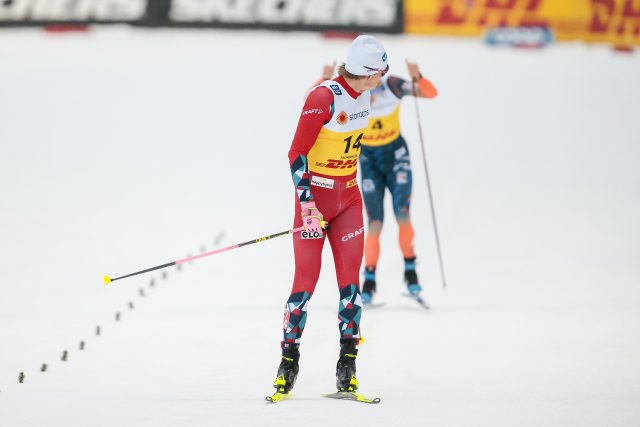
At 13.3 kilometers a small crack in Norway’s armor began to show as Burman and Halfvarsson were skiing fourth and fifth, refusing to let the Norwegians completely dominate. Musgrave had efficiently clawed his way back into contact with the lead group and was gathering himself as the Norwegians continued to set the pace at the front. Ogden was still skiing well, in 20th, but only 42 seconds off the front.
Musgrave continued to push and at 15.4 kilometers had worked to put himself into the lead. It was an impressive comeback for the British skier as he had worked hard to overcome his earlier mistake. He was now working with Klaebo and Toenseth to keep the speed high. At 16 kilometers there was another bonus sprint which increased the tempo again. Now the pack had broken into a group of five: three Norewegians, plus Musgrave and Halfvarsson.
With 3.3 kilometers left, Harald Oestberg Amundsen (NOR) went to the front, knowing that he had to establish a gap over Klaebo to have a chance at the finish. The back and forth was relentless with Musgrave then moving to the lead with the three Norwegians on his tail. Halfvarsson had been gapped and couldn’t keep with the group, though he gamely tried to rejoin it. It was now the three Norwegians at 18 kilometers chasing Musgrave!
With one kilometer left, the back and forth continued with Klaebo moving to the front. It was still the three Norwegians and Musgrave. Simen Hegstad Krueger (NOR) and Klaebo now traded places at the front with all four skiers forming one pack. In the final climb leading into the stadium it was three skiers spread across the front; Musgrave, Klaebo, and Krueger. All the racers knew that unless they had a gap on Klaebo their chances were slim in a sprint finish. Coming into the stadium Klaebo put in one of his trademark moves and tried to bury the field using the big downhill into the stadium to create a gap. As usual, his strategy was successful and he created separation between himself and the other contenders. On the final turn, Musgrave went wide and lost some speed. It probably didn’t matter as Klaebo had established a big enough lead to wave to the crowd as he crossed the finish. Musgrave had been able to fight forward for second place, with Toenseth taking third. It was a dramatic finish that thrilled the local crowd and kept Norway’s winning streak intact. But Musgrave had proven that there was at least an opportunity for a non-Norwegian to fight for the top spot.
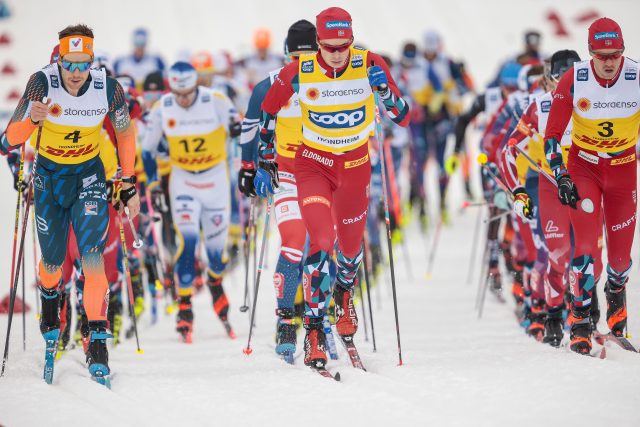
Ogden’s sixteenth place was the highlight for team USA. It was a very exciting race; as the Skiathlon often is. The hometown crowd came away pleased, and the Americans saw promise in it’s future with Ogden continuing to ski well.
Disaster during the race was barely averted when climate protesters attempted to string a barrier across the course. “On the Classsic loop, a couple of guys tried to stretch a chain or a wire across the course, but luckily some locals tackled them, American coaches told FasterSkier. “I’m very sympathetic to climate change, but I’m also sympathetic to the athletes having a safe competition and being able to compete . . . “They tried to interrupt it just as the skiers were about to get to that point, and the protesters were pushed aside, so it didn’t impede the race.” It was a close call for skiers, and FIS will have to do something to address this situation.
Men’s 20 k Skiathlon RESULTS



